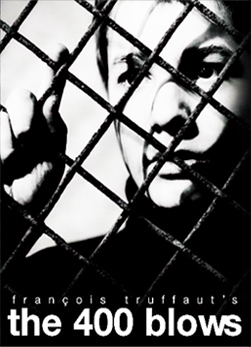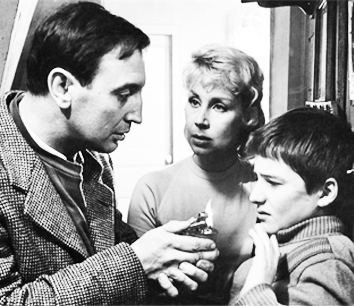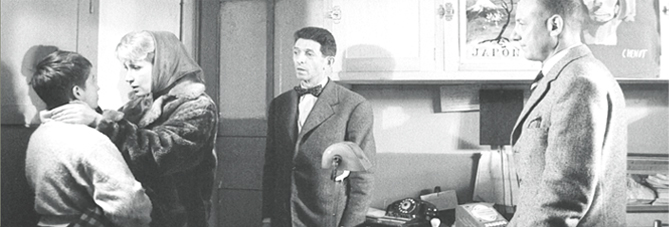 The 400 Blows earned François Truffaut the Best Director prize at the Cannes Film Festival — doubly impressive when you consider that it was his first movie, and the award came only a year after Trauffaut’s mercilessness as a film critic had gotten him booted from Cannes’ invite list altogether.
The 400 Blows earned François Truffaut the Best Director prize at the Cannes Film Festival — doubly impressive when you consider that it was his first movie, and the award came only a year after Trauffaut’s mercilessness as a film critic had gotten him booted from Cannes’ invite list altogether.
The 400 Blows (Les Quatre cents coups) was more than a semi-autobiographical film; it was also an elaboration of what the French New Wave directors would embrace as the caméra-stylo (camera-as-pen) whose writing style could express the filmmaker as personally as a novelist’s pen. It is one of the supreme examples of “cinema in the first person singular.”
The film was widely acclaimed, winning numerous awards, including the Best Director Award at the 1959 Cannes Film Festival, the Critics Award of the 1959 New York Film Critics’ Circle and the Best European Film Award at 1960’s Bodil Awards. It was nominated for Best Original Screenplay at the 32nd Academy Awards.
Most of the big directors of the ’70s — Francis Ford Coppola, Martin Scorsese, Steven Spielberg — credited Truffaut for inspiring them; Spielberg even cast Truffaut as an actor in Close Encounters of the Third Kind.
Norman Jewison, Richard Lester, and Akira Kurosawa all named The 400 Blows as one of their favorite movies.
The clarity and honesty with which the 400 Blows presents a moving story of the troubles of a 12-year-old boy are the film’s most critical accomplishment. Where previous films on similar subjects have been fatted and fictionalized with all sorts of adult misconceptions and sentimentalities, this is a smashingly convincing demonstration of life of a young adolescent- who is cool, firm and realistic, without a false note or a trace of goo, but adults see him as a troublemaker.
Inspired by Truffaut’s own early life, The 400 Blows shows a resourceful boy growing up in Paris and apparently dashing headlong into a life of crime. The film isn’t sensationalized or romanticized in the least . Little is done in the film for pure effect. Everything adds to the impact of the final shot.
 We meet Antoine when he is in his early teens, and living with his mother and stepfather in a crowded walkup where they always seem to be squeezing out of each other’s way.
We meet Antoine when he is in his early teens, and living with his mother and stepfather in a crowded walkup where they always seem to be squeezing out of each other’s way.
The mother (Claire Maurier) is a blond who likes tight sweaters and is distracted by poverty, by her bothersome son, and by an affair with a man from work. The stepfather (Albert Remy) is a nice enough sort, easy-going, and treats the boy in a friendly fashion although he is not deeply attached to him. Both parents are away from home a lot, and neither has the patience to pay close attention to the boy: They judge him by appearances, and by the reports of others who misunderstand him.
At school, Antoine has been typecast by his teacher as a troublemaker. His luck is not good. When a pinup calendar is being passed from hand to hand, his is the hand the teacher finds it in. Sent to stand in the corner, he makes faces for his classmates and writes a lament on the wall. The teacher orders him to decline his offending sentence, as punishment. His homework is interrupted. Rather than return to school without it, he skips. His excuse is that he was sick. After his next absence, he says his mother has died. When she turns up at his school, alive and furious, he is marked as a liar.

And yet we see him in the alcove that serves as his bedroom, deeply wrapped in the work of Balzac, whose chronicles of daily life helped to create France’s idea of itself. He loves Balzac. He loves him so well, indeed, that when he’s assigned to write an essay on an important event in his life, he describes “the death of my grandfather” in a close paraphrase of Balzac, whose words have lodged in his memory. This is seen not as homage but as plagiarism, and leads to more trouble and eventually to a downward spiral: He and a friend steal a typewriter, he gets caught trying to return it and is sent to the juvenile detention home.
The film’s most poignant moments show him set adrift by his parents and left to the mercy of social services. His parents discuss him sadly with authorities as a lost cause (“If he came home, he would only run away again”). And so he is booked in a police station, placed in a holding cell and put in a police wagon with prostitutes and thieves, to be driven through the dark streets of Paris, his face peering out through the bars like a young Dickensian hero.
He has a similar expression at other times in the film, which is shot in black and white in Paris in a chill season; Antoine always has the collar of his jacket turned up against the wind.

It is not surprising that one of the dominant, although subtle, motifs throughout Truffaut’s work is paternity. In The 400 Blows, the class in English pronunciation revolves around a question that can be articulated only with difficulty: “Where is the father?”—a phrase that resonates both within the film (Antoine has never known his real father) and in the director’s life.
This state of confused paternity is a direct reflection of post war French demography. In the immediate aftermath of the war, the population rose rapidly, though it was not simply a result of a predictable, immediate rise in births among traditional young French families, from new marriages or from the reunion of young couples separated by the war. Rather, sample maternity hospital surveys in the 1950s revealed that a third of pregnancies were unwanted.
Like Truffaut’s own experiences, the father abandons mother and son, and Doinel was only able to live because his own grandmother had convinced his mother not to abort the baby. Julien Doinel, Antoine’s stepfather, thus married his mother and gave Antoine his surname.
Truffaut, like his Italian neo-realist predecessors, explores the social experiences of a common family structure in post-war France and expresses the potential consequences of growing up in a frigid environment. This condition, and the manner in which the characters interact with one another were specifically tied to that certain period.

The film’s famous final shot, a zoom in to a freeze frame, shows Antoine looking directly into the camera (more arresting in 1959, before this technique became a stock-in-trade of television commercials) provides a mirror image of an earlier shot in the police station. When Antoine is arrested for stealing a typewriter, he is fingerprinted and photographed for the files. The mug shot is in fact a freeze-frame that conveys the definitive and permanent way in which he has been caught.
Truffaut used non-professional actors who were chosen based on how closely their own motives, traits, and tendencies conformed to the characters. Through the employment of non-professionals, The 400 Blows arrived at realism through subtle acting that is marked by a naturalism which never slips into parody or stylization.
Another way in which Bazin’s obsession with the attainment of realism on celluloid would find its way into Truffaut first full length effort was its use of location shooting. There were multiple reasons why this was done, some intellectual, and other pragmatic.
Intellectually, this was in reaction against the Classical model in which films were shot in studios, as was common at the time in Hollywood and France. Thus, shooting on location made a lot of sense, if a filmmaker was to achieve a documentary quality and realism in their work.
 Pragmatically, the film was shot on location because of Truffaut’s severely limited budget. In 1958, the average cost of a feature was $250 000. After borrowing $25 000 from his father-in-law, another $25 000 from friends, and yet another $25 000 from government subsidies, the total Truffaut had raised for the project was still far less than the average budget of a feature at the time.
Pragmatically, the film was shot on location because of Truffaut’s severely limited budget. In 1958, the average cost of a feature was $250 000. After borrowing $25 000 from his father-in-law, another $25 000 from friends, and yet another $25 000 from government subsidies, the total Truffaut had raised for the project was still far less than the average budget of a feature at the time.
The 400 Blows was among the first movies made without studio backing to show cinema’s potential for telling personal stories. Half a century later, it’s rarely been matched for its unsentimental and poignant view of childhood.
Hiring Henri Decae as his cinematographer, who had proven rather adept at shooting in natural lighting conditions with a hand-held camera, Truffaut made extensive use of the city as his backdrop, showing Paris from multiple vantage points and scales. By using the city itself as a background, the film would not only provide a realistic backdrop for the action, it would become a record of post-war Paris and the social realities of its inhabitants.
The Cinematographic techniques deployed by Truffaut in achieving a greater realism were the long take and the use of deep-focus photography.
With deep-focus photography, the viewers’ eyes can roam from foreground to background and around since everything contained within the screen is clear. This is closer to the way in which we perceive in reality. Moreover, it introduces ambiguity within the structure to the image, as the director does not prescribe what the audience must focus on. With the long take, scenarios are reproduced more realistically, as the viewers have a greater freedom in terms of interpreting the action in front of him.
This film is dedicated to Andre Bazin, the influential French film critic who took the fatherless Truffaut under his arm at a time when the young man seemed to stand between life as a filmmaker and life in trouble.
Cinema saved Francois Truffaut’s life, he said again and again. It took a delinquent student and gave him something to love, and with the encouragement of Bazin he became a critic and then made this film by his 27th birthday.
If the New Wave marks the dividing point between classic and modern cinema (and many think it does), then Truffaut is likely the most beloved of modern directors — the one whose films resonated with the deepest, richest love of moviemaking.



One Response to The 400 Blows